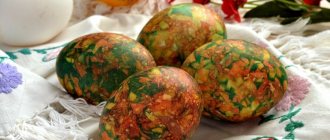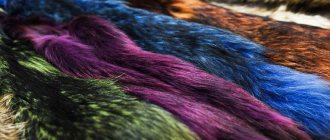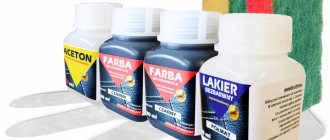According to legend, when the Christian saint Mary Magdalene saw the risen Christ, the eggs in her basket suddenly turned purple. Since then, every year, as an Easter custom, it is customary to paint boiled eggs in different colors. Among the Slavic peoples, yellow eggs symbolized the fertility of the earth and the spring revival of nature. The most popular and simplest method of preparing “sunny” colors for the Easter table is considered to be coloring with turmeric.
Turmeric is an ancient perennial plant from the ginger family. The bright yellow dye curcumin, widely used in the cooking of various nations, is extracted from the roots and stems of turmeric. However, India is considered to be the birthplace of the popular seasoning, where the well-known spice Curry began to be made from turmeric even one and a half thousand years ago.
For a long time, turmeric has been used not only as a spice, but also as a natural dye. Many people know how difficult it is to wipe this seasoning off the surface if it spills. But when preparing Easter eggs, this feature will help to obtain a deep and lasting color. Let's figure out how to achieve bright and uniform coloring at home easily and simply.
Preparing to dye eggs
On the eve of the holiday, many different food colors for coloring eggs appear on sale. But even though they are food-grade, they are still chemical compounds, and not everyone can use them, since they can cause allergic reactions and gastrointestinal disorders.
Turmeric is very persistent and difficult to wash off if used as a dye. If this is only a plus for eggs, since the color cannot be easily removed, then a big problem is created for the dishes and the skin of your hands: they will turn yellow. Therefore, it is advisable to adhere to the following recommendations:
- If you need to color pre-boiled eggs, it is advisable to use transparent glassware, since earthenware cups or mugs will be very difficult to clean even with the help of special products.
- If you plan to boil and color eggs at the same time, you must use stainless steel utensils rather than enameled ones. Moreover, it is advisable to take something that is not new, since even steel is very difficult to wash after turmeric.
- Before starting work, be sure to wear rubber gloves so as not to spend a lot of time washing your hands.
- When raw eggs are placed in boiling water, to which dye has been added, and boiled, the dyes acquire a golden color. If you decide to color raw eggs in this way, you need to take them out of the refrigerator about an hour before cooking and keep them at room temperature, otherwise they will crack during cooking. A quicker option: place eggs just taken out of the refrigerator into a container of warm water. In about 10 minutes they will already heat up to normal temperature.
- It is advisable to add salt to the water for boiling eggs at the rate of 1 tablespoon per 1 liter of liquid. This is done so that the protein, if the shell does crack, does not leak into the container with water. Vinegar added to water when boiling eggs helps them color more evenly.
- If you want the shade of the shell to be brighter, prepare a dye from turmeric bought by weight.
- Do not attempt to turn the eggs over during the coloring process. If you touch the shell with a spoon or anything else, marks will remain on the shell. As a result, you will get uneven coloring.
- To make colored eggs shine in the sun and look more attractive, brush them with a small amount of vegetable oil. This natural remedy, when coloring the product at home, will give the shell a beautiful shine.
It’s easy to color eggs for Easter at home; it’s important to prepare them correctly:
- First, you need to wipe the eggs with a sponge soaked in a solution of laundry soap to remove dirt and the stamp if the products were purchased in a store.
- Then it is advisable to wipe the prepared eggs with 6% vinegar, which removes fat from the surface of the shell, so the dye applies more evenly. Vinegar will also help to permanently remove the stamp if it was not removed during washing. It may happen that the stamp is still visible even after treatment with vinegar. No need to worry as it will disappear during cooking.
For coloring, you need to take eggs with a white shell, otherwise the golden hue after turmeric will be completely invisible. After the eggs have been colored with turmeric, to add shine to the shell (after the dyes have cooled), rub a small amount of vegetable oil. It is advisable to use refined water that does not have a characteristic odor.
Children especially love the coloring process. Invite them to do this work together. Kids find it interesting to watch the color changes.
Recipe for coloring raw eggs
When choosing the option of how to dye eggs for Easter in 2022 at home, the housewife combines two procedures - boiling and the actual dyeing, which occur simultaneously, that is, the eggs are boiled in a dye solution. This recipe is perfect if you need to quickly get some paint for the Easter table.
But it has one rather significant drawback - the color of the eggs will not be bright yellow, but a dull gold. It is necessary to prepare a bag of turmeric (20 grams) and for each liter of water - 1 tablespoon of 6% vinegar. Add salt to prevent the eggs from cracking during cooking and the whites from leaking.
The process of coloring raw eggs with turmeric simultaneously with boiling step by step:
- Pour turmeric into a bowl of cold water and mix gently. Place a saucepan of water over medium heat.
- Wait until the water boils, then reduce the heat to low and very carefully lower the eggs, one at a time, into the pan using a tablespoon or slotted spoon so that they do not hit the bottom and crack.
- Then add vinegar and mix gently, being careful not to touch the eggs. When a spoon touches the eggs, stains remain on the shell, and this is not very beautiful.
- Boil the eggs for 10-15 minutes, then turn off the heat and carefully place the eggs with a spoon on a paper towel. Leave until completely dry.
You can easily adjust the brightness and color saturation yourself. For a more saturated color, you need to keep the eggs in the coloring broth longer; if you need a color of lower intensity, reduce the time. Checking the color is very simple - take out the egg with a tablespoon and look at the saturation of the shade.
Coloring already boiled eggs
Boiled eggs are much easier to color than raw eggs. In this case, you don’t have to worry that they will crack during cooking and the protein will take on the color of the dye used. Another obvious advantage is that when dyeing boiled eggs, the color is more saturated.
The only thing to consider is the time it takes for the products to color. It takes about 12 hours for the shell to absorb color.
Coloring boiled eggs with turmeric for Easter at home is as follows:
- Turmeric in an amount of 20 g is mixed with 1 liter of water and heated for 2-3 minutes.
- The resulting liquid must be filtered. This will help remove undissolved sediment.
- The resulting amount of liquid can color 5 eggs. For the color to become saturated, the eggs must remain in the dye for at least 12 hours.
After the specified time, you need to take out the paints and let them dry. You can't wipe them off. To make the eggs shine, they are greased with vegetable oil using a pastry brush.
Popular questions and answers
Together with Rushana Kukhtina, we will understand the intricacies of preparing for the Easter celebration, answering the most popular questions.
Can you dye brown eggs with turmeric?
Of course you can! Turmeric is a natural pigment, so there will be no harm. Of course, the color will not be as “sunny” as on white eggs, but brown eggs will take on a richer dark amber hue. Mixing Easter eggs of different colors will make the presentation more interesting.
How to color quail eggs with turmeric?
The technology for coloring quail eggs is no different from the process of coloring chicken eggs, except for one feature. Quail eggs should be cooked until tender for no more than 5 minutes. This time will be enough for the shell to acquire a rich amber color. And the spots on quail eggs will give Easter colors a fancy ornament. The main thing is not to forget to turn them over so that the color turns out more uniform.
Turmeric + red cabbage
Turmeric can also be used to color eggs green. Of course, you won’t be able to get a bright shade. It will be muted.
Red cabbage can turn the shell a beautiful blue hue. But if you mix it with turmeric, you get a natural green dye, with which you can color eggs a delicate shade of green.
To prepare the dye, you need to boil the cabbage and separately, boil the turmeric dye. It will take no more than 3 minutes to prepare each solution. When both dyes have cooled, take one part of each and mix in a separate container.
The mixture must be thoroughly mixed, otherwise the expected result will not work. Place the eggs in the resulting liquid and leave for 12 hours.
Hibiscus + turmeric
Hibiscus can also be used to color eggs for Easter. With its help, at home, you can paint the shell a light shade of purple, blue or gray. The latter can be obtained if the dye acts on the shell for a long time.
By mixing turmeric dye with hibiscus, you can get a solution that will color eggs green, yellow-green or olive. To get paints, you should follow the instructions:
- Color eggs using turmeric solution.
- Prepare hibiscus by pouring 20-30 g of strong tea into 1 liter of boiling water and leaving for 10 minutes.
- Place the eggs in the prepared tea and leave for a few minutes.
- Take out the paints and dry them.
- The procedure should be repeated until the shell acquires the desired shade.
Eggs painted in this way will become a real decoration for the holiday table.
So as not to paint everything around
Turmeric is a very, very durable dye. You've probably noticed that if the seasoning crumbled while cooking pilaf, and even got on a damp area of the table or stove, it is almost impossible to completely wipe the stain off a light surface - a pale yellow mark remains. Therefore, when working with this natural dye, you need to follow a number of rules:
- The working surface must be protected with a waterproof covering - oilcloth or bag.
- We protect our hands with rubber, cellophane, latex gloves.
- We use either an old pan (which we don’t mind) or a steel pan without additional coatings. But you definitely don’t need to paint eggs in enamel dishes - it will be impossible to wash them!
- Involving children in the painting process in this case is not the best idea. Most likely, a few yellow spots left by children's fingers will remain in your kitchen forever after such an experiment.
How to decorate eggs
Eggs colored yellow, gold or green look very beautiful, but sometimes you want more variety. In this case, you can use decor.
Paints decorated with leaf prints look very aesthetically pleasing. To make them, you need to straighten the leaves of dill or parsley, place the egg in a nylon stocking and tie it with thread.
Then place the egg in the dye and leave it there. The shell, which is located under the leaf, will not be colored. You will get a beautiful pattern.
You can also decorate eggs with unusual ornaments. To make it, wet an egg and roll it in uncooked rice. After this, put the product in a nylon sock, tighten it with thread and place it in the dye. When the time is up, remove the eggs and rinse them with cold water. The rice will be washed off, and neat spots will remain in its place.
You can also create unusual Easter eggs using beautiful paper patterns. These can be Easter motifs, floral and other prints. Carefully cut out the design and glue it to the shell using egg white.
The pattern obtained after tying the eggs with threads also looks unusual. After dyeing and removing the threads, you will get a beautiful striped pattern.
The way to color eggs with turmeric for Easter in 2022 is absolutely safe, simple and, last but not least, affordable. The dyes will turn out beautiful, and you won’t have to worry about the health of your loved ones.
A little history
The egg is one of the products about which there is a lot of debate among scientists around the world. Some nutritionists claim that this product can be called the best as a dietary food, while others completely refutes this statement.
It is believed that the egg was consumed by primitive man long before the chicken became poultry. It would not be out of place to say that people have been using chicken eggs to prepare various dishes for several millennia. Many cultures revered the egg as a symbol of life, fertility and rebirth. In Christianity, colored eggs are a symbol of Easter. And ancient Egypt had its own belief. The Egyptians claimed that the egg was created by the gods from the moon and the sun.
There is an assumption who was the first to eat eggs - these were the inhabitants of ancient India and Southeast Asia. Later, Greece and Egypt, and the rest of the countries of the ancient world learned about them. In the 17th century, the French really liked cocktails that included eggs and sour fruit juices.
Later, in the 19th century, this product began to be dried. This practice was used by the military during World War II and helped many survive.
This is interesting ! Packaging containers for storing eggs, in the form of cardboard trays familiar to us, were invented only at the beginning of the 20th century.
It is very difficult to answer the question in which country they learned how to cook a chicken egg deliciously. But those who were among the first could not help but note that an egg can easily satisfy hunger, it is easily absorbed by the body, and it has excellent taste.










